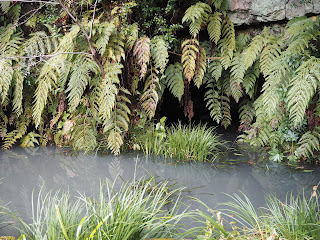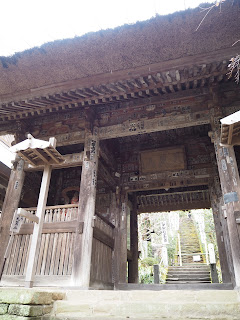Kamakura 33 Kannon Pilgrimage in My Order
Old Kamakura 33 Kannon Pilgrimage was organized in Kamakura County, Sagami Province, in the Edo Period. Due to the movement to abolish Buddhism early in the Meiji Period, some member temples were abolished and the old pilgrimage declined during the period. In the Taisho Period, New Kamakura 33 Kannon Pilgrimage was organized within Kamakura City.
After paying a courtesy visit to Tsurugaoka-Hachiman-gu Shrine, I walked eastward out of the precincts. A couple of blocks later, I found a signpost to show my way to the grave of Minamoto Yoritomo (1147-1199), at the foot of which there used to be Hokke-do Temple, my essentially first call today. Technically speaking, Yoritomo’s body was supposed to have been buried under the hall of Hokke-do Temple. The tombstone we see today was built in the Edo Period by the Shimazu Shigehide (1745-1833).
Old Kamakura 33 Kannon Pilgrimage #8 Hokke-do Temple
Minamoto Yoritomo (1147-1199), the founder and first shogun of the Kamakura Shogunate, enshrined his guardian Buddhist image, the Amitabha statue, in Hokke-do Temple. After his death on January 13, 1199, his body was buried in the temple, presumably under it. The Buddhist ceremony for the first anniversary of his death was held in the temple.
On May 2nd, 1217, when Wada Yoshimori (1147-1213) attacked the palace of Minamoto Sanetomo (1192-1219), the third Shogun, Sanetomo escaped to Hokke-do Temple. The battle lasted for 2 days, and Yoshimori was finally killed by a subject of Edo Yoshinori at twilight on the 3rd.
On June 5th, 1247, when Miura Yasumura (1184-1247) lost to the Hojo Clan, he and 500 of his family members, relatives, and subjects committed suicide in the temple.
In 1872, the temple was abolished due to the Gods and Buddhas Separation Order issued by the Meiji Restoration Government in 1868. The statue of Cintamanicakra, who usually has 6 arms and holds chintamani (a wish-fulfilling jewel) in one of the six, was moved to Raigo-ji Temple nearby. Whose wishes had the chintamani fulfilled?
Address: 2 Chome-5-7 Nishimikado, Kamakura, Kanagawa 248-0004
Phone: 0467-61-3848
The area has another site of Hokke-do Hall, or there used to be another Hokke-do Hall nearby, which was built to pray for the comfort of Hojo Yoshitoki (1163-1224) in the other world. I’m afraid I have to say that the hall for Yoshitoki might have been bigger than that for Yoritomo, who was Yoshitoki’s lord.
After visiting the sites of Hokke-do, I climbed a hill. A long one. As I was tired and walked with downcast eyes, I almost overlooked the alley to Raiko-ji Temple. At the foot of the stairway to the temple, there was a signboard of Raiko-ji Temple. Behind the signboard, I barely found a stone monument which said there used to be a Taihei-ji Temple, which was my destination monument of the day.
After Ashikaga Yoshiaki (1493?-1538) and his first son, Yoshizumi (?-1538), were killed in the battle, his younger children fled to Awa Province, counting on the protection of Satomi Yoshitaka (1507?-1574). It was during those days that Yoshitaka’s first son, Yoshihiro (1530-1578), and Ashikaga Yoshiaki’s first daughter met. Later, however, Yoshiaki's second and third sons were sent to Sekido-ji Temple in Kazusa Province and his 3 daughters were sent to Taihei-ji Temple in Kamakura. They became under the patronage, or the supervision, of the Later Hojo Clan.
At the age of 8 or 9, Satomi Yoshihiro was determined.
After coming of age, Yoshihiro kept fighting fiercely and aggressively against the Later Hojo Clan. He continued fighting for some 18 years. Finally, in 1556, he succeeded in intruding into Kamakura temporarily. He saw Ashikaga Yoshiaki’s first daughter, who was Nun Shogaku (?-1576?) at the time. She had been determined too. With her noble bloodline as a young lady of the Ashikaga Shogunate Clan, she could have been married to a son of a powerful family as her younger sister did. The younger sister got married to Uesugi Norihiro (?-1551), the Regent of the Kanto Deputy Shogunate. Instead, Shogaku became a nun at Taihei-ji Temple, and stayed there nearly 2 decades. Yoshihiro was 26 years old at the time. She might have been older than him. Yoshihiro asked Nun Shogaku to come back to Awa Province, and she accepted his proposal. Hojo Ujiyasu (1515-1571), the head of the Later Hojo Clan, criticized their attempt as “incomprehensible” but all he could do was destroy Taihei-ji Temple.
New Kamakura 33 Kannon Pilgrimage #5 Raiko-ji Temple
Raiko-ji Temple was founded by Priest Ikko in 1293, when the 1293 Kamakura Earthquake occurred on 27 May 1293, destroyed many temples, and killed 23,024 people. In the confusion following the earthquake, Hojo Sadatoki (1271-1311), the Regent of the Kamakura Shogunate, killed Taira Yoritsuna (1241-1293), a constant hindrance to Sadatoki, and 90 of Yoritsuna's followers.
Raiko-ji Temple might have been revived after the earthquake, or founded for the first time to mourn the victims of the earthquake or those who were killed in the purge.
Raiko-ji Temple's statue of Cintamanicakra, who usually has 6 arms and holds chintamani (a wish-fulfilling jewel) in one of the six, is known for its “domon” (it literally means Clay Pattern). They stuck clay on a wooden statue so that it looks like reliefs. When carving reliefs needs technical skills, “domon” enabled less skilled artisans to make equal effects. The “domon” technique was utilized in Kamakura to catch up with Kyoto artisans.
Address: 1 Chome-11-1 Nishimikado, Kamakura, Kanagawa 248-0004
Phone: 0467-24-3476
After Raiko-ji Temple, I was walking along the foot of hills slightly downward. I found a road running along the bottom of a ravine. I walked along the street and found Sugimoto-Kannon Busstop. I was almost there, the #1 member temple of the Bando 33 Kannon Pilgrimage, the second oldest 33 Kannon pilgrimage in Japan. The first temple of the second oldest pilgrimage! I was excited with high expectations. Only to find a mountain temple.
New Kamakura 33 Kannon Pilgrimage #1 Sugimoto-dera Temple
In 734, Empress Asukabe (701-760) heard an oracle from Avalokitesvara, “The central rule hadn’t spread to eastern provinces yet. I wish you to contribute treasure to save people.” To establish public order there, she ordered Fujiwara Fusasaki (681-737), who was her brother and a minister, and Gyoki (668-749) to build temples there. Gyoki enshrined an eleven-faced Ekadasamukha statue in Kamakura. Its hall came to be called Okura Kannon-do Hall.
On November 23rd, 1189, the temple burned down but Monk Jodai rescued the Ekadasamukha statue from the fire and saved it under a Japanese cedar tree. Thereafter, the temple came to be called Sugimoto-dera, namely, Under Ceder Temple. In 1191, Minamoto Yoritomo (1147-1199) visited the ruins of the fire, and donated repair expenses.
When Kamakura was invaded by Kitabatake Akiie (1318-1338) on his way from Mutsu Province to recapture Kyoto for Emperor Go-Daigo (1288-1339), Shiba Ienaga (?-1337), the Regent of the Kamakura Office of the Ashikaga Shogunate, lost to Akiie and killed himself in the temple.
Sugimoto-dera Temple is also the #1 member temple of the Bando 33 Kannon Pilgrimage.
Address: 903 Nikaido, Kamakura, Kanagawa 248-0002
Phone: 0467-22-3463
I took a bus from Sugimoto-Kannon Busstop and got off at Daigakumae Busstop. I had visited the start of the Kamakura Shogunate and was heading to the end of it.
New Kamakura 33 Kannon Pilgrimage #2 Hokai-ji Temple
Hokai-ji Temple was founded by Ashikaga Takauji (1305-1358) after 1333, when the Hojo Clan was destroyed by Emperor Go-Daigo (1288-1339), at the site of office of the Regent of the Kamakura Shogunate, to which the Hojo Clan had succeeded for generations.
Address: 3 Chome-5-22 Komachi, Kamakura, Kanagawa 248-0006
Phone: 0467-22-5512
I walked out of the temple. I made the left turn at the second corner. I climbed another hill. Halfway up the hill, I found 2 caves behind a vacant lot. Every holy place in Kamakura has a cave. Ancient people there might have done open-air burials in those caves. The vacant lot was the site of Tosho-ji Temple, the family temple of the Hojo Clan.
Nitta Yoshisada (1301-1338) raised his army in Kozuke Province with 150 strong cavalry on May 8th, 1333. He was to meet the 100,000 strong cavalry of the Kamakura Shogunate somewhere between Kozuke and Sagami Provinces. The shogunate had been established by the Minamoto Clan, beating down the Taira Clan, but had been controlled by the Hojo Clan, who were the branch clan of the Taira Clan, after the 4th shogun. The Nitta Family was one of the powerful branch families of the Minamoto Clan.
Yoshisada had pride in his bloodline and content against the Hojo Clan. When he arrived at Tone River, the number of his cavalry increased to 7,000 strong. After crossing the river, the number jumped to 207,000. He defeated the garrisons of the Kamakura Shogunate along the Iruma River on May 11th. Before daybreak on May 21st, Yoshisada finally stormed into Kamakura, and cornered the Hojo Clan into their family temple, Tosho-ji Temple, where hundreds of clan members killed themselves.
After the 2 caves, I found the cave where Hojo Takatoki (1304-1333), the 14th Regent of the Kamakura Shogunate, was said to have killed himself. It was still up the hill covered with a growth of weeds. Even in the depths of winter, the scene reminded me of a haiku poem Matsuo Basho (1644-1694) composed:
Summer weeds
Which cover
The site of warriors' dreams.































0 Comments:
Post a Comment
<< Home